You are using an out of date browser. It may not display this or other websites correctly.
You should upgrade or use an alternative browser.
You should upgrade or use an alternative browser.
Paris France Fire Dept - Rescue and Unit Responses
- Thread starter mack
- Start date
- Joined
- Jun 27, 2007
- Messages
- 3,470
During the fire at the Cathedral of Notra Dame they mentioned that the fire fighters are actually members of the Army. Did not know that.Apartment multiple alarm fire and rescue
Responses
Fire services in France
From Wikipedia
The fire service in France is organised into local fire services which mostly cover the Departments of France, with a few exceptions. There are two types of fire service:
The Paris Fire Brigade (Army) and Marseille Naval Fire Battalion (Navy) are military units providing fire protection to Paris and Marseille.
The rest of France has civilian fire services organized, supervised and trained by the French Ministry of the Interior; specifically, they fall under the Civil Defence and Security Directorate (Direction Générale de la Sécurité Civile et de la Gestion de Crise, DGSCGC).
There are approximately 246,900 fire service personnel in France operating 15,642 emergency vehicles out of 6,894 emergency centres. In addition to providing fire protection and rescue, the French fire service is also one of the providers of emergency medical services.
In French, firefighters are known as sapeurs-pompiers or informally as pompiers. The former originally refers to the military-based Paris Fire Brigade. Pompier (firefighter) comes from the word for "pump", referring to the manual pumps originally used for firefighting. Sapeur means "sapper" and refers to the first official firefighting unit created by Napoleon I which was part of the military engineering arm. Firefighters in the Marseille Marine Fire Battalion are known as marins-pompiers (sailor-firefighters). The usual name of a civilian fire services is a service
départemental d'incendie et de secours (SDIS) (Departmental Fire and Rescue Service). Young French citizens can fulfill the mandatory service Service national universel (SNU) in one of the fire brigades.
Organization
The fire service is organized based on the various Departments. Each department has a Service Departmentaux d'Incendie et de Secours (SDIS, Departmental Fire and Rescue Service) responsible for operations within its territory, with a few exceptions:
Paris and the three departments of the petite couronne (Hauts-de-Seine, Seine-Saint-Denis and Val-de-Marne) are covered by the Paris Fire Brigade.
Bouches-du-Rhône is covered by both the Marseille Naval Fire Battalion and a civilian Bouches-du-Rhône SDIS.
Lyon Metropolis and Rhône are both covered by the Rhône SDIS, reflecting Rhône's boundaries before 2015.
Corsica is divided between two fire services, reflecting the departments that existed from 1975 to 2017.
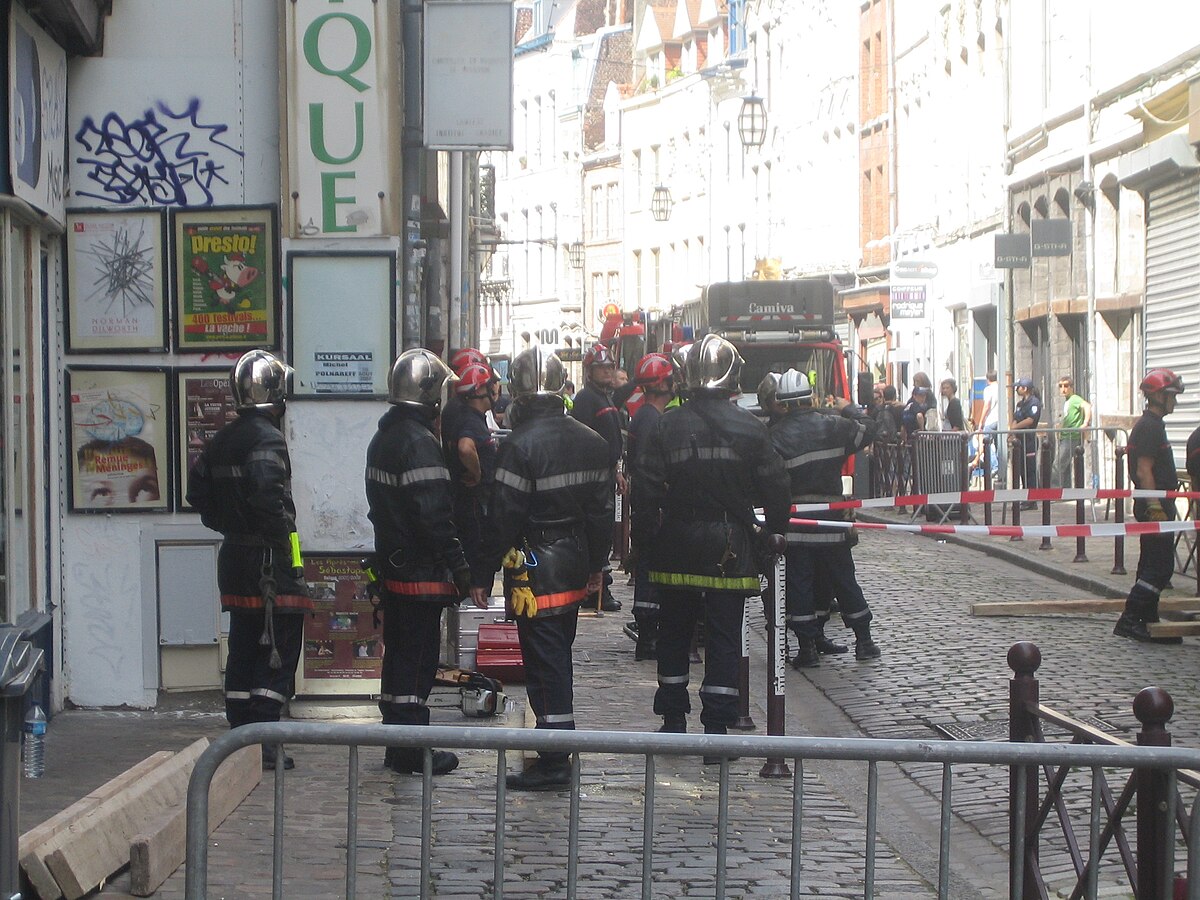
Fire services in France - Wikipedia
Last edited by a moderator:
Paris Fire Brigade
https://military-history.fandom.com/wiki/Paris_Fire_Brigade#articleComments| Brigade de sapeurs-pompiers de Paris | |
|---|---|
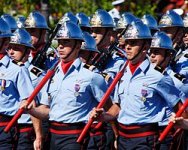 Firemen of the Paris brigade at the 2008 Bastille Day military parade on the Champs-Élysées, Paris. | |
| Active | 1793–present |
| Country | |
| Branch | French Army |
| Type | Firemen |
| Size | 8,340 |
| Motto(s) | "Sauver ou périr" (Save or Perish) |
| Colors | Red & black |
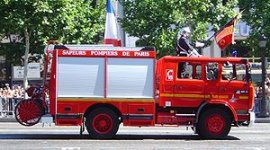
Fire engine of the Brigade des sapeurs-pompiers de Paris parading
The Paris Fire Brigade (French Brigade des sapeurs-pompiers de Paris, BSPP), is a French Army unit which serves as the fire service for Paris and certain sites of national strategic importance. The brigade's main area of responsibility is the City of Paris and the surrounding départements of Seine-Saint-Denis, Val-de-Marne, and Hauts-de-Seine. It also serves the Centre Spatial Guyanais in Kourou, the Military Rocket Test Centre in Biscarosse, and the gas plant of Lacq-Artix. The other departments of metropolitan Paris have their own fire brigades. The brigade is a unit of the French Army's Engineering Arm (Génie) and the firefighters are therefore sappers (sapeurs, thus sapeurs-pompiers). With 8,550 firemen, it is the largest fire brigade in Europe and the third largest urban fire service in the world, after the Tokyo Fire Department and New York City Fire Department. The brigade is placed at the disposal of the Paris Prefecture of Police in an arrangement similar to that of the French Gendarmerie. Its motto is "Save or Perish" (French "Sauver ou périr").
Another military force responsible for firefighting in France is the Marseille Naval Fire Battalion (BMPM). The remainder of France has civilian fire and rescue services (services départementaux d'incendie et de secours). See: Fire service in France
Mission
As any French firefighter, their missions are- Fire Suppression
- Emergency Basic Life Support ambulance
- Utility Safety – Gas Leaks et al.
- Personal Assistance – Victims services, SAR lost persons
- Motor vehicle collision response
- Protection of beings
- Patrol, Reconnaissance and Research
- Animal rescue
- Pollution control and HAZMAT Response
- Alarm response
- Guiana Space Centre of Kourou Guyane
- test field for missiles in Biscarosse
- site for extraction and processing of natural gas in Lacq-Artix
History

The Fire Brigade's headquarters in Paris
Founded in 1793 as the Corps des gardes-pompes de la ville de Paris and following the 23 hour Austrian Embassy Fire in 1810 became a military organisation by imperial decree by Emperor Napoléon. On 18 September 1811, it became the Bataillon de sapeurs-pompiers de Paris and was expanded to the Régiment de sapeurs-pompiers de Paris in 1867. On 1 March 1967 became the Brigade des sapeurs-pompiers de Paris.
Selection and instruction
The operational personnel (hommes du rang i.e. privates) are usually engaged for five years. They must have French nationality, be between 18 and 25 years old, have a clean criminal record and have at least a vocational training certificate (CAP). The selection is three days long, with sports tests, psychomotor tests, medical examination, etc.Training takes place in the Instruction Grouping (Groupement d'instruction, GI), at the fort of Villeneuve-Saint-Georges. The first period lasts two months, with the first aid and first responder training, and basic military instruction (including shooting).
The sapper then undertakes practical training of four months in an operational fire company (compagnie d'incendie); he takes part in personal assistance and utility safety operations.
The sapper then returns to the Instruction Grouping for two further months for his fire training. He is then permanently attached to a fire company.
Resources

Firemen of the Paris brigade, Bastille Day 2008 military parade on the Champs-Élysées, Paris.
The BSPP consists of 8,340 personnel who man 81 stations and facilities who conduct 1200 operations daily.
- 463 pieces of equipment
- 130 Pumpers
- 63 Aerial Devices
- 66 Ambulances
- 71 Command and Patrol vehicles
- 133 Special Engines
- Fireboats
- All terrain vehicles
- Four wheel drives
Corporate Organisation

Gen. Bernard Périco, as of 2014 commanding officer of the Paris Fire Brigade
The brigade is commanded by a Brigade General as part of the French Army's engineering arm. The brigade commander directly controls the Information and Public Relations Bureau, and who is assisted a Colonel-Adjutant, a General Council called a Cabinet and a Chief of Staff who controls the following Bureaus:
- General Studies Bureau
- Financial Programs and Budget Bureau
- Assistant Chief for Employment
- Operations Bureau
- Formation and Instruction Bureau
- Prevention Bureau
- Assistant Chief for Logistics
- Techniques Service
- Infrastructure Service
- Administrative Service
- Telecommunications and Information Service
- Assistant Chief for Human Resources
- Human resources Bureau
- Personnel Welfare Bureau
- Chief Doctor
- Emergency medical service/SAMU
- Chief of the Health Service
Field Organisation
- First fire group – Northeast Paris and Seine-Saint-Denis
- Second fire group – Southeast Paris and Val-de-Marne
- Third fire group – west Paris and Hauts-de-Seine
- Instructions group
- Services group
First fire group (Premier groupement d'incendie)
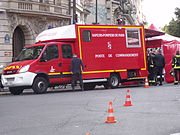
Mobile HQ of Paris firemen in action.
The First fire group of the Paris Fire Brigade covers Northeast Paris and Seine-Saint-Denis and is Headquartered at:
- 12 rue Carpeaux 75018 Paris tel: 01.42.26.83.18
- Fire Group Staff
- EMS/SAMU
- Facilities (Maintenance) Group
- 7th at Blanche
- 9th at Montmartre
- 10th at Landon
- 12th at Ménilmontant
- 13th at Aulnay-sous-Bois
- 14th at Clichy-sous-Bois
- 24th at Montreuil
- 26th at Saint-Denis
Second fire group (Deuxième groupement d'incendie)
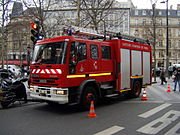
Iveco fire apparatus in Paris.
The Second Fire Group of the Paris Fire Brigade covers Southeast Paris and Val-de-Marne and is Headquartered at:
- 16 avenue Boutroux 75013 Paris Tel: 01.45.82.58.18
- Fire Group Staff
- EMS/SAMU
- Facilities (Maintenance) Group
- 1st at Chaligny
- 2nd at Massena
- 8th at Rousseau
- 11th at Sévigné
- 15th at Champigny
- 17th at Créteil
- 22nd at Rungis
- 23rd at Saint-Maur
Third fire group (Troisième groupement d'incendie)

Fire support truck near Champerret HQ.
The Third Fire Group of the Paris Fire Brigade covers Western Paris and Hauts-de-Seine and is Headquartered at:
- 14 rue Henry Regnault 92400 Courbevoie. Telephone: 01.49.04.74.18
- Fire Group Staff
- EMS/SAMU
- Atelier Group
- 3rd at Port Royal
- 4th at Colombier
- 5th at Champerret
- 6th at Grenelle
- 16th at Boulogne
- 21st at Plessis Clamart
- 27th at Gennevilliers
- 28th at Puteaux
Instructions Group (Groupement d'instruction)
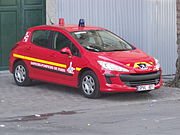
Peugeot 308 serial SPVL921.
The Instructions Group of the Paris Fire Brigade provides education and training to all Paris firefighters. It consists of the following:
- Group Staff
- EMS/SAMU
- Center for Formation and Cadres
- Center for the Instruction of Recruits
- Basic Training Company
- Auto School, driving and repairs
- Support Company
Special Services
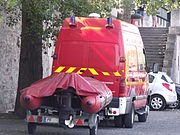
Renault Mascott light truck of the Scuba unit of Paris firemen.
Controlled by Headquarters
- Divers/SCUBA
- Search and Rescue
- Canine Service
- Music
- Gymnastic Team
- Air Service
- Boat Service
Operations
The BSPP has about 1 200 interventions per day. In 2001:- 1st fire group: 163 081 interventions amongst which 9 606 fires;
- 2nd fire group: 136 078 interventions amongst which 5 583 fires;
- 3rd fire group: 150 376 interventions amongst which 5 234 incendies.
- per day: 19 interventions per 100 000 inhabitants;
- per year: 7 300 interventions per 100 000 inhab., amongst which 331 fires per 100 000 inhab.

Paris Fire Brigade
The Paris Fire Brigade (French Brigade des sapeurs-pompiers de Paris, BSPP), is a French Army unit which serves as the fire service for Paris and certain sites of national strategic importance. The brigade's main area of responsibility is the City of Paris and the surrounding départements of...
The Paris fire brigade: something new, something borrowed, something blue
The third largest fire department in the world is wearing a firefighter suit designed by Sioen. The fabric or assembly that was used, was especially designed for the BSPP’s needs.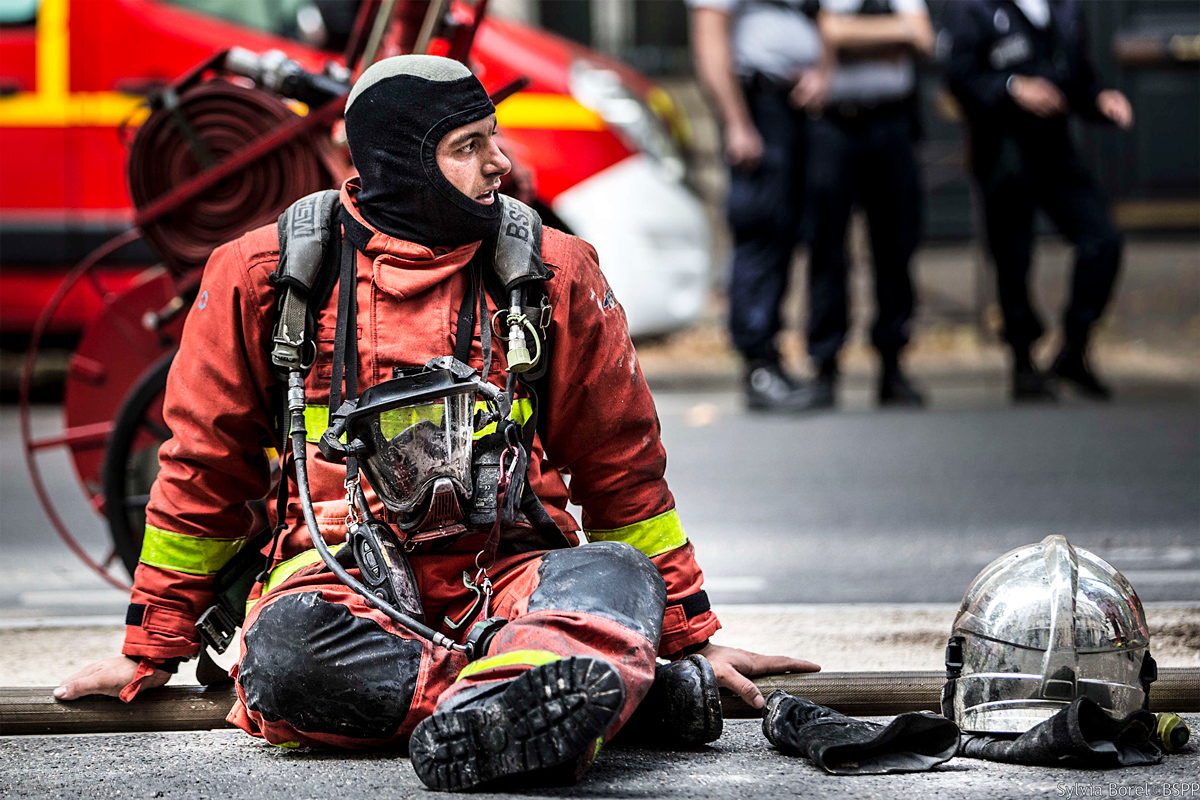
New Paris fire brigade suit
The Paris Fire Brigade (BSPP) has been wearing Sioen Fire garments since 2017.
